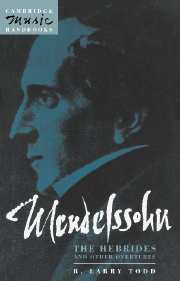6 - Some thoughts on Mendelssohn's orchestration
Published online by Cambridge University Press: 23 November 2009
Summary
According to conventional wisdom Mendelssohn did not achieve significant innovations in the art of orchestration. As a cursory review of his scoring practices confirms, he relied for the most part upon the classical orchestra of Beethoven, with occasional additions, usually designed to underscore a special effect or programmatic idea. In the woodwind, Mendelssohn customarily limited himself to paired instruments. Exceptions to this rule include the addition of the piccolo in Prosperous Voyage (to suggest the gathering force of the wind) and in Die erste Walpurgisnacht, where the instrument's shrill accents are associated with the pagan Druids, and the use of the contrabassoon and serpent, again in Prosperous Voyage, to suggest the depth and broad expanse of the sea (the serpent also appears in the oratorio St Paul to reinforce the bass line).
In the brass, Mendelssohn typically scored for paired horns and trumpets; an early exception includes the opera Die Hochzeit des Camacho (1827), in which an expanded brass section (four horns, two trumpets, and three trombones) announces the knight-errantry of Don Quixote. Four horns are also required in the Ruy Blas Overture, Lobgesang and Scottish Symphonies, and in Elijah. Trumpets appear in pairs in Mendelssohn's scores, except in the coda of Prosperous Voyage, in which a third trumpet is added to bolster the Jubelruf as the vessel approaches the safety of the harbour.
- Type
- Chapter
- Information
- Mendelssohn: The Hebrides and Other Overtures , pp. 84 - 88Publisher: Cambridge University PressPrint publication year: 1993



